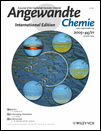Gas-Filled Polyelectrolyte Capsules†
D.G.S. acknowledges the Alexander von Humboldt Foundation for an individual research fellowship. The authors thank Dr. Jürgen Hartman and Rona Pitschke for transmission electron microscopy analysis, Anne Heilig for atomic force microscopy analysis, and Roy Knocke for Raman spectra.
Graphical Abstract
Full of air: Electrostatic layer-by-layer assembly of polyelectrolyte multilayers was successfully accomplished on the surface of an air microbubble (core). The resulting polyelectrolyte shell stabilizes the air microbubbles against collapse and prevents the dissolution of air in aqueous media. Air-containing polyallylamine/poly(styrene sulfonate)(PAH/PSS) microcapsules have a broad size distribution (1–20 μm).




